Feeding the world: a contribution to the debate
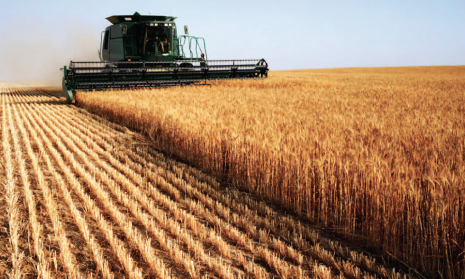
Summary
It is often claimed by proponents of organic farming that, if used worldwide, it would provide sufficient food for a growing world population.
Here we make a critical assessment of this claim for wheat, a major cereal crop and source of food throughout the world.
We have compared organic and conventional systems, examined some of the publications and claims in detail, and found a typical ratio of organic:conventional wheat yields of 0.65.
Nitrogen (N) fixation by legumes, the main source of N supply in organic systems, is shown to be much too small and variable to support large and consistent wheat yields.
Our conclusion agrees with that of a recent report by the University of Reading’s Centre for Agricultural Strategy that organic agriculture cannot feed the world using current technologies.
However, we believe that there is a need to reduce the over-optimal use of fertilisers and agricultural chemicals and to better manage crop rotations to reduce nutrient losses to the environment and crop losses to pests and diseases.
There is also a wider societal need to reconsider diet in the context of health and the ability of world agriculture to supply the wants of its anticipated 9 billion population.
Key words: Organic farming, Conventional farming, Sustainable food supplies, Nitrogen fixation, Legumes, Wheat
Abbreviations
CAS, Centre for Agricultural Strategy, University of Reading;
FAO, Food and Agriculture Organisation, United Nations;
FYM, Farmyard Manure; NUE, Nitrogen Use Efficiency;
K, Potassium;
Mg, Magnesium;
N, Nitrogen;
P, Phosphorus;
S, Sulphur;
Organic: Conventional (yields): O:C.
Introduction
A recent paper by Badgley et al. (2007) claimed that organic farming, if used worldwide, would provide sufficient food for a growing world population.
This claim was based on a literature survey of: (1) a comparison of organic and conventional yields; (2) an assessment of the amounts of nitrogen (N) fixed by legumes.
These were then used to calculate potential food production. The paper stimulated much critical response (see Cassman, 2007; Hendrix, 2007; Avery, 2007; Connor, 2008).
Badgley et al.’s (2007) evaluation was not related to any particular organic certification criterion, but the organic systems studied did rely greatly on the application of manure or the use of cover crops to replace fertiliser nitrogen.
The use of manure and cover crops is not, of course, unique to organic farming systems; they are used by many ‘conventional’ (i.e. non-organic) farmers in the UK and beyond.
Conventional farming is also very variable: UK farmers use a range of short or long rotations, minimum tillage or no tillage combined with ploughing, livestock fed on grass, grass/clover or other forms of fodder and returning variable amounts of manure, slurry and bought-in compost and other biosolids to the land.
The actual practices on each farm result from long experience and with some, exceptions are usually site specific. Such managerial skill is crucial.
All farmers take a holistic view of their farm, but the over-riding criterion is the market price for produce set against the cost of production. The primary goal of any farmer is to maximise income and maintain the quality of their land.
If arguments are to be made about feeding the world from organic farming then the primary concern must be the yield ratios of organic:conventional for the major cereal crops and livestock.
Wheat is grown on ca 215 million ha worldwide, is tolerant of arid climates and, containing more protein than corn or rice, is one of the primary food staples.
Therefore, for brevity and simplicity, we have made a critical assessment of the claims that organic farming can feed the world using wheat as an exemplar.
Organic vs conventional wheat yields
Badgley et al. (2007) relied heavily on data from experiments not farmers’ fields.
While this is better than anecdotal information, there are some disadvantages:
(1) experiments lack the economic drivers that determine what farmers actually do;
(2) while yields from experiments are useful indicators of potential yield they are obtained under closely-controlled and often near-ideal conditions with scientific expertise that does not exist on practising farms; the difficulties of transferring experimental results to actual farming practice have long been recognised (Davidson and Martin 1968).
Additionally, Badgley et al. (2007) made no attempt to rate the credibility of the ratios of organic to conventional yield they presented.
Measurements made in just one year are presented as having the same credibility as those made over 10-25 years or more.
The correct way for the performance of organic farming to be compared with other forms of farming is to assess the averages from many farms over large areas and several years (see Jones and Crane 2009 and section 5 below).
Although this information is available in the UK it does not seem to be available elsewhere.
Figures from Elm Farm Research Centre, the primary organic research institute in the UK, indicate that the average UK organic winter wheat yield (assessed from data on many farms) is ca. 4 t ha-1 but about 8 t ha-1 for conventional agriculture; a ratio of organic:conventional (hereafter O:C) of 0.5 (see Lampkin and Measures 2001; Welsh et al., 2002).
Also, statistical methods were developed in the 1930's by Fisher (see Street, 1990) to enable researchers to measure differences in yields between farms and fields. Their use should be mandatory.
An assessment of organic vs conventional food quality by Dangour et al. (2009) searched 52,471 potentially relevant articles and identified 162 studies (137 crops and 25 livestock products) that made the required comparisons; of these only 55 met the required statistical quality controls. Clearly rigorous data are lacking.
Badgley et al’s data
Table 1 summarises the ratios of yields of O:C wheat for the data used by Badgley et al. (2007). To comment on just some of the references used to support a high O:C ratio (rows 1 and 2):
Granstedt and Kjellenberg (1996) [O:C = 0.8] stated “The fertiliser application rates for the various treatments were adjusted to bring about comparable yields”.
Mader et al. (2002) [O:C = 0.87] used results from a long-running Swiss experiment, which applied manure at an organic regulation level of 1.4 animals ha-1 (and yielded about 4 t wheat grain ha-1).
However, the fertiliser application of 125 kg N ha-1 to the ‘conventional’ treatment was well below the optimum. The conventional Swiss average wheat yield over 20 years, according to the FAO, is 6.5 t ha-1, which would give an O:C ratio of about 0.6. Mader et al.
(2002) state that “cereal yields under organic management are typically 60- 70% of those under conventional management”.
McGuire et al. (1998) [O:C = ratios 0.98, 0.93, 0.83, 0.81] studied cover crops on dryland organic farms over winter, but herbicides were used to control weeds and thus organic procedures were not followed.
National Research Council (1989) [O:C = 1.02] reviewed 'alternative' agriculture. But the aims of 'alternative' systems, as described on page 27 of the report, are not organic and would be subscribed to by many conventional farms in the UK (see for example LEAF (2010).
In addition, the O:C ratio refers to the yields of two different rotations both of which received insecticides and are therefore not produced under an organic regime.
Nguyen and Haynes (1995) [O:C = 0.68] examined three pairs of farms and provided an estimate of an O:C ratio of 0.68 .
The paper comments that soil nutrient reserves are being depleted rapidly at one of the farms.
Raupp and Konig (1996) [O:C = 1.01] stated “In order to achieve comparable yields with organic and mineral fertiliser, composted manure had to be used in relatively high amounts”, sometimes up to 60 tonnes ha-1.
New data
We also examined the references in rows 3 and 4 of Table 1. To comment on a few of these:
Bochenhoff (1986) found O:C ratios of 0.7 for winter wheat on 145 farms and 0.72 for spring wheat on 52 farms.
Grimm (1988) compared 40 'alternative' farms with over 800 conventional farms to give an average O:C ratio 0.69.
Higginbotham et al. (2000) and Trewavas (2004) reported results from the 10-year Boarded Barns Farms study, with certified organic and conventional matched fields over 7 years, which gave O:C ratios of 0.61, 0.75, 0.64, 0.65, 0.7, 0.61, 0.51, with an average of 0.64.
Ryan et al. (2004) reported O:C ratios of matched organic and conventional farms of 0.83, 0.37, 0.53 and 0.16.
Stoppler (1989) compared 23 varieties of wheat in organic and conventional agriculture and found O:C ratios of 0.75, 0.95 and 0.73, with an average of 0.81.
Data from the Broadbalk experiment at Rothamsted
The 167-year old Broadbalk winter wheat experiment at Rothamsted is often used to ‘prove’ that crops fertilised with manure yield as well as those fertilised with chemically produced fertilisers and thus support organic farming.
This comparison relates to two experimental treatments on Broadbalk, one given only moderate amounts of fertiliser N (144 kgNha-1 yr-1plusP,K,MgandS) and the other 35 t ha-1 cattle manure (FYM; Figure 1).
Badgley et al. (2007) referred to these experiments twice in their article under different references (e.g. Jenkinson et al. 1994) and used them as a supposed comparison of organic to conventional; the O:C ratio quoted was 1.15.
The wheat yields from the 35 t ha-1 manure applied to the FYM plot on Broadbalk have matched those from moderate amounts of fertilisers (144 kg N ha-1 yr-1) within statistical variation over the lifetime of the experiment (Goulding et al. 2008) and are currently about 7 t ha-1; the true O:C yield ratio is thus 1.
More importantly, (1) the manure-only experiment is not organic because substituting manure for fertiliser is not certified organic practice, besides which herbicides, insecticides and fungicides are used on Broadbalk; and (2) the fertilizers applied to the conventional treatment are not optimal.
Best yields on Broadbalk currently average 9-10 t ha-1 yr-1 (but canbe>11tha-1yr-1) and are achieved either with optimum rates of N fertiliser at between 250 and 300 kg N ha-1 yr-1 or the manure PLUS an extra 96 kg N fertiliser ha-1 yr-1 in spring, the exact yields depending on seasonal weather and pests and diseases.
FYM plus N fertiliser in spring produces a good yield but at the cost of very poor N use efficiency and large losses of nitrate to water, about 30% larger than those from the optimum fertiliser N application (Goulding et al. 2000).
Organic farmers can apply manure containing up to 250 kg N ha-1 yr-1 to any one field, but the farm average must be no more than 170 kg N ha-1 yr-1 (Soil Association 2009). The regulations on stocking rates are set to achieve the same limits, with estimated outputs of N per animal.
The UK Fertiliser Recommendations (Defra, 2010) estimate that 1 t cattle manure contains 6 kg N.
Thus an organic farmer could apply up to 40 t FYM ha-1 to any one field, but with an average of no more than 28 t ha-1 across the farm; similar to the amount applied to Broadbalk.
Organic yields of up to 7 t ha-1 are therefore achievable with adequate pest, disease and weed control and if sufficient manure is available but the ethos of organic farming is not about replacing fertiliser with manure; it is based around crop rotations.
Another crucial point to note from the Broadbalk and other long-term experiments at Rothamsted, is that they were started in the mid-19th century because there was insufficient manure, even then, to provide nutrients for crop growth.
To provide 35 tonnes of manure/ha requires 3.5 adult cattle ha-1. There are about 4 million adult cattle in the UK and 4 million ha of arable farmland. (Respective figures in the USA are 100 and 200 million).
Thus to provide sufficient manure for high wheat and other crop yields would necessitate increasing the numbers of cattle about 3.5 fold (7 fold in the USA).
Their winter consumption of corn and wheat would increase by the same amount and the land devoted to food crops would have to decline. Methane production, a potent greenhouse gas, would also increase.
In summary, our literature analysis agrees with those of Offermann and Nieberg (2000) and Jones and Crane (2009 and Section 5 below) that organic wheat yields are ca two-thirds those of conventional systems (Table 1).
Data from the Broadbalk Experiment and that of Raupp and Konig (1996; section 3.1) show that similar yields to conventional can be obtained from organic systems, but only by replacing fertiliser N with an equal amount of N in a very large application of manure, which is not good organic practice nor is it sustainable.
Legume nitrogen fixation
Badgley et al. (2007) claim that N fixation by legumes could be sufficient to replace the current use of N in fertiliser.
N fixation is a biological process subject to the vagaries of the weather as well as site-specific constraints such as the availability of other nutrients, notably P (Giller 2001).
The mean amount of N fixation for cover crops, quoted by Badgley et al. (2007), is 100 kg N ha-1 with standard deviations of 33-95%. Of the N fixed, 66% was estimated to be mineralised and taken up and incorporated into grain.
This is based on a single reference (Hoyt and Hargrove 1986), who suggest that a selection of green manures (crimson clover, hairy vetch and Austrian winter peas) accumulated more than 150 kg organic N ha-1 and subsequently released 100 kg inorganic N ha-1 into the soil for the subsequent summer crop.
This estimate, in turn, is based on data from US experiments of the early 1980s, most of which are referenced in Hoyt and Hargrove (1986) as 'unpublished'.
If all of the 100 kg N ha-1 that Badgley et al. (2007) estimate to be fixed by cover crops is utilised, this would be enough for about 6 t ha-1 of wheat and 10 t ha-1 maize (Raun and Johnson 1999), but this is unlikely.
Even if the N-use efficiency of 66% is accepted, this would provide sufficient N to produce only about 4 t ha-1 wheat and 6-7 t ha-1 maize.
World-wide, the efficiency of use of N from fertiliser is 33%, a figure easily calculated from the fertiliser N used in agriculture and the N that ends up in seed (Raun and Johnson 1999).
What is the actual N-use efficiency from a grass-clover ley or a legume green manure? A number of papers place the figure at 20% or less (Giller and Cadisch 1995; Harris et al. 1994; Kramer et al. 2002; Ladd and Amato 1986).
Others report that only 9-33% of the legume N incorporated into the soil the previous year is taken up into the crop, let alone translocated into the grain (Muller 1987, 1988a,b; Ladd et al. 1983).
Berry et al. (2002) used a well-established relationship between soluble soil N and the protein content of wheat seed and showed that, in an organic soil containing a potential 300 kg N ha-1, the wheat plant only appeared to be able to access 50-60 kg N ha-1, i.e. a Nitrogen Use Efficiency of about 20%.
It can be argued that, over the long-term, legume fixed N not utilised in grain will build up soil N and thus increase the yield in the long-term.
However, on the long-term Ley-Arable Experiments at Rothamsted and Woburn, organic C in soil (and, by inference N) increased by only 10- 20% after 30-60 years of a 3-year grass-clover ley followed by 2/3-years’ arable crops (Johnston et al. 2009).
Using a more realistic N-use efficiency of 20%, the 100 kg N ha-1 would yield only about 1 t ha-1 wheat or 2 t ha-1 maize, and no more than 60-80 kg protein ha-1.
This is enough to support about 4-5 people ha-1 on a very simple vegetarian diet (Smil 2001).
Badgley et al. (2007) reference Kramer et al. (2002) as indicating that a legume cover crop can provide the same yield as mineral fertiliser.
However, Kramer et al. achieved this by using a mixture of a vetch cover crop together with 330 kg N ha-1 from turkey manure, providing a total of 435 kg N ha-1 compared with a conventional fertiliser application of about half that value.
The N content of the turkey manure is equivalent to that in about 47 t ha-1 cattle manure; an amount that cannot be supplied sustainably.
In addition to the amount of N supplied in organic rotations, there is a lack of synchrony of mineralisation of organic nitrogen with crop requirements.
Wheat, for example, needs to take up much of the N very quickly in spring to form the leaf canopy. Spring applications of soluble fertiliser easily meet that requirement.
Mineralisation of soil organic N certainly occurs in spring, but not usually quickly enough to meet crop demand.
Mineralisation also continues throughout the season and beyond the growth period in late summer and autumn, putting N at risk of loss to air and water during periods of rainfall through autumn to spring (Goulding et al. 2000); leaching of N from organic and conventional farms is now known to be similar in magnitude (Goulding 2000; Trewavas 2004).
Some have suggested that the risks of eutrophication and global warming potential from organic farms are higher than from conventional farms (Williams et al. 2006).
The UK’s capacity to produce food under organic agriculture
Jones and Crane (2009) sought to calculate the ability of organic agriculture to supply the UK with a range of agricultural products.
They took a selection of representative organic farms and multiplied up current organic yields/outputs on the basis of area, or the number of farm holdings (Table 2; full data are in Jones and Crane 2009; Table 17, page 49).
Weighting according to area did not take into account the fertility building phase of crop production whereas weighting by farm holding did. This approximately halves the yield on an area basis over a rotation and gives the potential for self-sufficiency in wheat as ca 33%.
The authors conclude that “...it would be unfair to ask if an organic agriculture could feed the nation, for obviously it could not, at least not with current technologies.” But then neither does conventional agriculture under the current regime.
“The real problem for organic agriculture would be the supply of eggs, poultry and pig meat....Also problematic would be the current decline in demand for red meats,...” .
This is simply because in order to meet the N requirements for wheat, the rotational organic systems would supply, according to CAS figures ca 170% of the beef and 160% of the sheep meat we currently eat.
As stated realistically by Woodward and Meier-Ploeger (1999), who are strong proponents of organic farming, but also highly critical of what might be called the ‘colour supplement’ view of organic food, they emphasise that the debate cannot focus on whether organic farming can feed the world.
The debate must focus on whether the world can adapt its diet and markets to systems such as organic that require less non-renewable inputs, but produce sufficient calories for a balanced diet.
Discussions and Conclusions
The mineralisation of soil organic matter and crop residues is clearly an important source of N for crops but, to sustain the yields necessary to feed a growing world population, this must be augmented by fertilisers and manures where available.
Soluble fertiliser can much more accurately provide nutrients when the growing crop needs it (synchronisation), whereas organic material improves soil structure, water holding capacity, microbial diversity and root development.
Claims that fertilisers damage the soil (reiterated by Badgley et al. 2007) were first made by Steiner (Pfeiffer 1940) can be rejected, as the Broadbalk Experiment clearly shows.
Connor (2008) calculated the carrying capacity of organic agriculture at 3–4 billion people.
From our own review of the literature, Connor’s (2008) paper, and the recently-published report from the CAS (Jones and Crane 2009), one must conclude that organic agriculture cannot feed the world in the way that it is now fed and seems increasingly wished to be fed.
Rapidly developing populations in India and China want more and better food, especially more meat. Organic food is more expensive, often greatly so, the higher price being compensation for lower yields and greater variation and greater risk of crop loss.
Any attempt to convert world agriculture to organic production would increase world food prices enormously, and those most at risk would be the poorest nations that are unable to provide sufficient produce of their own.
However, there is always room for improvement in all kinds of farming and we have no difficulty in agreeing with Badgley et al. (2007) about the need to improve soil quality by adding organic material, reducing unnecessary use of fertilisers and agricultural chemicals, and optimising rotations to reduce losses to pests and diseases.
And both organic and conventional systems will have to develop and adapt to predicted climate change.
References
Avery, D. (2007) Organic abundance report: fatally flawed. Commentary. Centre for Global Food Issues. http://www.thetruthaboutorganicfoods.org /2007/09/14/%e2%80%9corganic-abun- dance%e2%80%9d-report-fatally-flawed/ (Accessed 10 February 2011).
Badgley, C., Moghtader J., Qunitero, E., Zakern, E., Chapell, J., Avile ́s-Va ́zquez, K., Samulon, A. and Perfecto, I. (2007). Organic agriculture and the global food supply. Renewable Agriculture and Food Systems, 22, 86-108.
Berardi, G.M. (1978). Organic and conven- tional wheat production - examination of energy and economics. Agro-Ecosystems, 4, 367-376.
Berry, P.M., Sylvester-Bradley, R., Philips, L., Hatch, D.J, Cuttle, S.P., Rayns, F.W. and Gosling, P. (2002). Is the productivity of organic farms restricted by the supply of available nitrogen? Soil Use & Management. (supplement), 18, 248-256.
Bochenhoff, E. (1986). Analyse der Beitrebs und Produktionsstrukturen sowie der Naturalertrage Imalternativen Landbau Berichte uber Landwirtschaft, 64, 1-39.
Cassman, K.G. (2007) Editorial response by Kenneth Cassman: can organic agricul- ture feed the world—science to the rescue? Renewable agriculture and Food systems, 22, 83-4.
Connor, C.J. (2008). Organic agriculture cannot feed the world. Field Crops Research, 106, 187-190.
Dangour, A.D., Dodhia, S.K., Hayter, A., Allen, E., Lock, K. and Uauy, R. (2009). Nutritional quality of organic foods: a systematic review. American Journal of Clinical Nutrition (published online ahead of print 29 July 2009), 6pp. doi: 10.3945/ajcn.2009.28041.
Davidson, B.R. and Martin, B.R. (1968). Experimental research and farm production. Ag-Econ Res. Report No 7. University of West Australia Press Nedlands, West Australia.
Defra (2010) Fertiliser Manual (RB209). 8th edition. TSO, Norwich.
Dlouhy, J. (1981). Alternative forms of Agriculture- Quality of Plant Products from Conventional and Biodynamic Growing. Report 91. Department of Plant Husbandry, Swedish University of Agricultural Sciences. Uppsala. 143 pp.
Entz, M.H. Guildford, R. and Gulden, R. (2001). Crop yield and soil nutrient status on 14 organic farms in the eastern portion of the northern Great Plains. Canadian Journal of Plant Science, 81, 351-354.
FAO. (2002) Selected Indicators of Food and Agriculture Development in Asia-Pacific Region - 1991-2001. Food And Agriculture Organization Of The United Nations Regional Office For Asia And The Pacific, Bangkok, Rap Publication: 2002/19.
Giller, K.E. (2001). Nitrogen Fixation in Tropical Cropping Systems. CAB International, Wallingford.
Goulding, K.W.T. (2000). Nitrate leaching from arable and horticultural land. Soil Use and Management, 16, 145-151.
Goulding, K.W.T., Poulton, P.R., Webster, C.P. & Howe,M.T. (2000). Nitrate leaching from the Broadbalk Wheat Experiment, Rothamsted, UK, as influenced by fertilizer and manure inputs and the weather. Soil Use & Management, 16, 244-250.
Goulding, K.W.T., Jarvis, S.C.J. and Whitmore, A.P. (2008). Optimising nutrient management for farm systems. Philosophical Transactions of the Royal Society of London, Series B, 363, 667-680.
Gransted, A.G. and Kjellenberg, L. (1996). Quality investigations with the K trial, Jarna and other Scandanavian fertilisation experi- ments. In Quality of Plant Products Grown with Manure Fertilisation Ed: J. Raupp. Volume 9. Institute for Biodymanic Research. Darmstadt. pp.3-12.
Grimm, M. 1988. Zum Agrarbericht (1988). Lebendige Erde, 3, 166-169.
Harris, G.H., Hesterman, O.B., Paul, E.A., Peters, S.E. and Janke, R.R. (1994). Fate of legume and fertiliser 15N in a long term cropping systems experiments. Agronomy Journal, 86, 910-915.
Hendrix, J. (2007) Editorial response by Jim Hendrix. Renewable agriculture and Food systems, 22, 84-5.
Higginbotham, S., Leake, A.R., Jordan, V.W.L. and, Ogilvy, S.E. (2000). Environmental and Ecological Aspects of Integrated, Organic and Conventional Farming Systems. Aspects of Applied Biology, 62, 15-20.
Hoyt, G.D. and Hargrove W.L. (1986). Legume cover crops for improving crop and soil-management in the southern united- states. Hortscience, 21, 397-402.
Jenkinson, D.S., Bradbury, N.J. and Coleman, K. (1994). In: Long-term Experiments in Agricultural and Ecological Sciences. Eds. R.A.Leigh, and A.E. Johnston. CAB International, Wallingford, UK. pp. 117- 138.
Johnston, A.E., Poulton, P.R. and Coleman, K. (2009). Soil organic matter: its importance in sustainable agriculture and carbon dioxide fluxes. Advances in Agronomy, 101, 1- 57.
Jones, P. and Crane, R. (2009) England and Wales under organic agriculture. How much food could be produced? CAS Report 18. Centre for Agricultural Strategy, Reading, 66pp.
Kitchen, J.L., McDonald, G.K., Shepherd, K.W., Lorimer, M.F. and Graham, R.D. (2003). Comparing wheat grown in South Australian Organic and Conventional wheat farming systems. 1. Growth and Grain Yield. Australian Journal of Agricultural Research, 54, 889-901.
Kramer A.W., Doane, T.A., Horwath, W.R. and van Kessel, C. (2002). Combining fer- tiliser and organic inputs to synchronise N supply in alternative cropping systems in California. Agriculture Ecosystems and Environment, 91, 233-243.
Ladd, J.N. and Amato, M. (1986). The fate of nitrogen from legume and fertiliser sources in soils successively cropped with wheat under field conditions. Soil Biology and Biochemistry, 18, 417-425.
Ladd J.N., Amato, M., Jackson, R.B. and Butler J.H.A. (1983). Utilisation by wheat crops of nitrogen from legume residues decomposing in soils in the field. Soil Biology and Biochemistry, 15, 231-238.
Lampkin, N. and Measures, M. (2001). Organic Farm Management Handbook. WIRS, Aberystwyth and EFRC Newbury.
LEAF (Linking Environment And Farming) (2010) LEAF’s Integrated Farm management (IFM).
LEAF, Stoneleigh, Warwicks, UK. (http://www.leafuk.org/ leaf/farmers/LEAF's%20IFM.eb)
Leu, A.F. (2004). Organic Agriculture Can Feed the World. Acres, USA, Vol. 34, No1.
Levi, M. (1979). Principles of Bio-Organic Agriculture. The Biosphere, 8, 30-35.
Lockeretz, W., Shearer, G. and Kohl, D.H. (1981). Organic farming in the corn belt. Science, 211, 540-547.
Mader, P., Fliessbach, A., Dubois, D., Fried, P. and Niggli, U. (2002). Soil fertility and biodiversity in organic farming. Science, 296, 1694-1697.
Mason, H.E., Navabi, A, Frick, B.L. O'Donovan, J.T. and Spaner D.M. (2007). The Weed-Competitive ability of Canada western red spring wheat cultivars grown under organic management. Crop Science, 47, 1167- 1175.
McGuire, A.M., Bryant, D.C., and Denison, R.F. 1998. Wheat yields, nitrogen uptake, and soil moisture following winter legume cover crop vs. fallow. Agronomy Journal, 90, 404–410.
Muller, M.M. (1987). Leaching of subter- ranean clover derived N from a loam soil. Plant and Soil, 102, 185-191.
Muller, M.M. (1988a). The fate of clover derived 15N nitrogen during decomposition under field conditions: effects of soil type. Plant and Soil, 105, 141-147.
Muller M.M. (1998b). The fate of clover derived nitrogen 15N during decomposition under field conditions. Effects of liming and fertilisation. Plant and Soil, 111,121-126.
National Research Council. (1989). Alternative Agriculture. Washington, D.C. National Academy Press.
Nguyen, M.L. and Haines, R.J. (1995). Energy and labour efficiency for three pairs of conventional and alternative mixed crop- ping farms in Canerbury, New Zealand. Agriculture Ecosystems and Environment, 52,163-172.
Offermann, F. and Nieberg, H. (2000). Economic performance of organic farms in Europe. Organic Farming in Europe: Economics and Policy, Vol 5, University of Hohenheim, Stuttgart.
Pfeiffer, E. (1940). Biodynamic farming and gardening: soil fertility renewal and preservation. New York/London, Anthroposophic Press/Rudolf Steiner.
Poutala, R.T., Korva,J. and Varis, E. (1993). Spring wheat cultivar performance in eco- logical and conventional cropping systems. Journal of Sustainable Agriculture, 3, 63-83.
Raun, W.R. and Johnson, G.V. (1999). Improving nitrogen use efficiency for cereal production. Agronomy Journal, 91, 357-363.
Raupp, J. and Konig, U.J. (1996). Biodynamic preparations cause opposite yield effects depending upon yield levels. Biological Agriculture and Horticulture, 13, 175-188.
Riverra-Ferre, M.G. (2008). The Future of Agriculture. EMBO Reports, 9, 1061-1066.
Robertson, G.P. Paul, E.A. and Harwood, R.R. (2000). Greenhouse gases in intensive agriculture. Science, 289, 1922-1925.
Ryan, M. H., Derrick, J. W. and Dann, P. R. (2004). Grain mineral concentrations and yield of wheat grown under organic and conventional management. Journal of the Science of Food and Agriculture, 84, 207-216. I Smil, V. (2001). Enriching the Earth. Cambridge, MIT Press.
Smith, R.G., Menalled, F.D. and Robertson, G.P. (2007) Temporal yield variability under conventional and alternative management systems. Agronomy Journal, 99, 1629-1634.
Smolik, J.D., Dobbs, T.L. and Rickerl, D.H. (1995). The relative sustainability of alterna- tive, conventional, and reduced-till farming systems. American Journal of Alternative Agriculture, 10, 25-35.
Soil Association. (2009). Soil Association organic standards for producers. Revision 16, January 2009. Soil Association, Bristol.
Stockdale, E.A., Shepherd, M.A., Fortune, S. and Cuttle, S.P. (2002). Soil fertility in organic farming systems - fundamentally different? Soil Use & Management, 18 (Supplement), 301-308.
Stonehouse, D.P. (1991).The economics of tillage for large-scale mechanised farms. Soil and Tillage Research, 20, 333-351.
Stoppler, H. Kolsch, E. and Vogtmann, H. (1989). Impact of wheat breeding in an agricultural low input system. Journal of Agronomy and Crop Science, 162, 325-332.
Street, D.J. (1990). Fisher’s contributions to agricultural statistics. Biometrics, 46, 937- 945.
Trewavas, A. (2004). A critical assessment of organic farming-and-food assertions with particular respect to the UK and the poten- tial environmental benefits of no-till agricul- ture. Crop Protection, 23,757-781.
Vereijken, P. (1986). From conventional to integrated agriculture. Netherlands Journal of Agricultural Science, 34, 387-393.
Walker, D. and Smith, A. (1992). Evaluation of spring wheat, oat and hulless oat and barley cultivars under an organic production protocol. Adaptation Research Reports, 14, 257-260.
Welsh, J.P., Phillips, L, and Cormack, W.F. (2002). The long term agronomic perform- ance of stockless rotations. In: UK Organic Research 2002. Ed. J. Powell. Proceedings of the COR conference. Aberystwyth, pp 47-50.
Williams, A.G., Audsley, E. and Sandars, D.L. (2006). Energy and environmental bur- dens of organic and non-organic horticul- ture and agriculture. Aspects of Applied Biology, 79, 19-23.
Woodward, L. Can organic farming feed the world? Elm Farm Research Centre, 6pp. I Woodward, L. and Meier-Ploeger, A. (1999) “Raindrops on roses and whiskers on kittens”. Consumers’ perceptions of organic food quality. Elm Farm Research Centre, march 1999, 4pp.
Wookey, B. (1987). Rushall – the story of an organic farm. Oxford, Blackwell.
Acknowledgements
This paper has been developed from ‘K.W.T. Goulding, A.J. Trewavas and K.E. Giller 2009, Can organic farming feed the world? A contribution to the debate on the ability of organic farming systems to provide sustainable supplies of food, International Fertiliser Society, Proceedings No. 663, 28 pp’. Rothamsted Research is an institute of the UK Biotechnology and Biological Sciences Research Council.
Figures
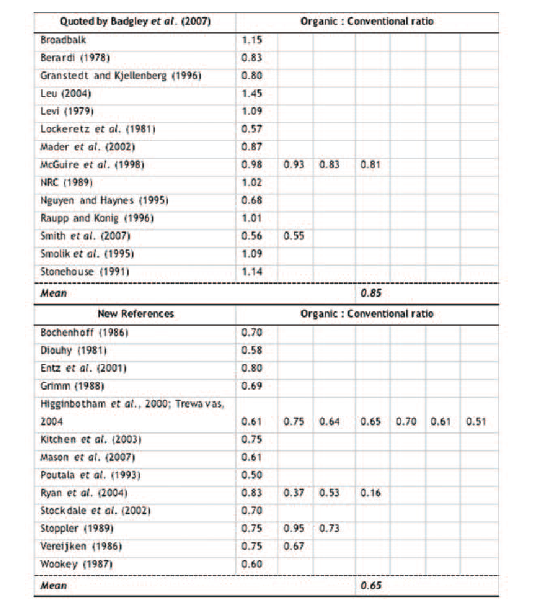
Table 1: Comparison of ratios or organic: conventional wheat yields using publications referenced by Badgley et al. (2007) with those from references founded by the authors.
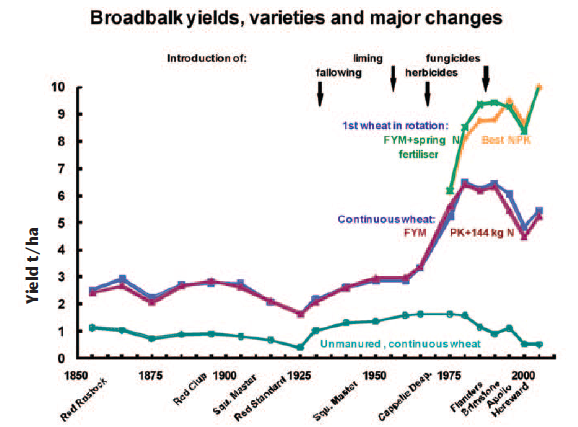
Fig. 1: Yields of wheat grain for selected plots on the Broadbalk Experiment 1843-2008
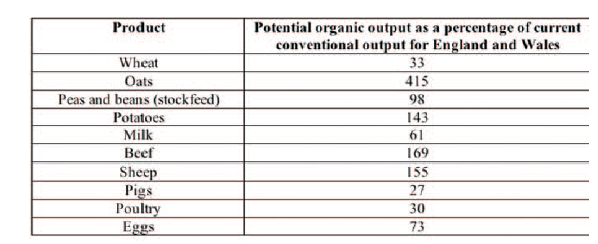
Table 2. Estimates of the potential organic production if all farms were organic as a percentage of current conventional production in England and Wales, weighted by farm type. (Adapted from Jones and Crane, 2009).
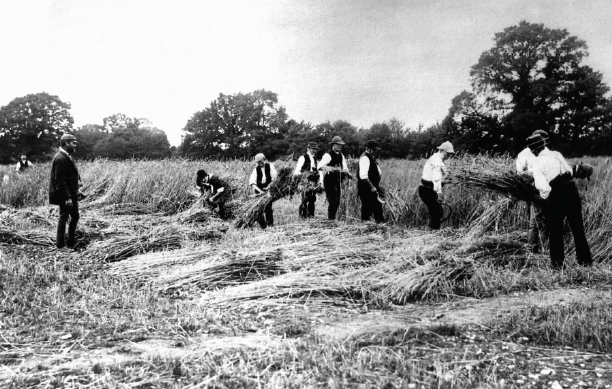
Plate 1: Harvesting on Broadbalk. An historical photograph
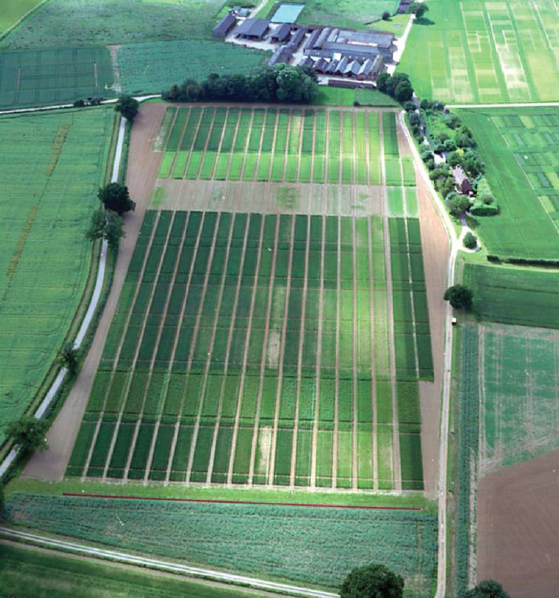
Plate 2: Now in its 168th year, the Broadbalk Wheat Experiment compares organic manures with fertilisers supplying the major plant nutrients for their effects on the yield of winter wheat. The field consists of plots 320 m long by 6 m wide. The photograph shows very clearly the main effect of nitrogen on yield. The palest plots towards the RHS received no or very small amounts of nitrogen whereas the darkest green plots were provided with excessive amounts of farmyard manure (far RHS) or large amounts (>200 kg ha-1 yr-1, LHS) of nitrogen fertiliser.

